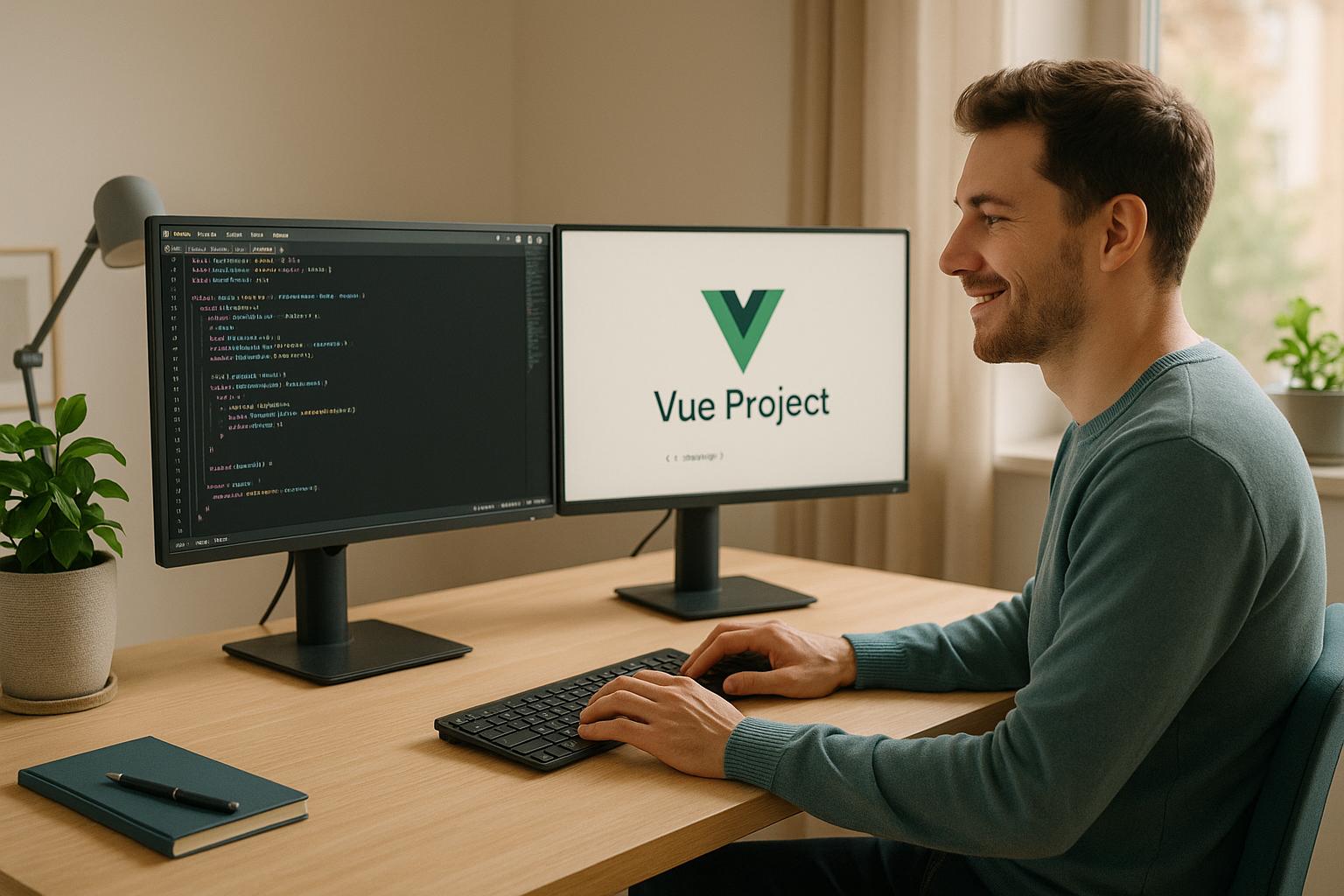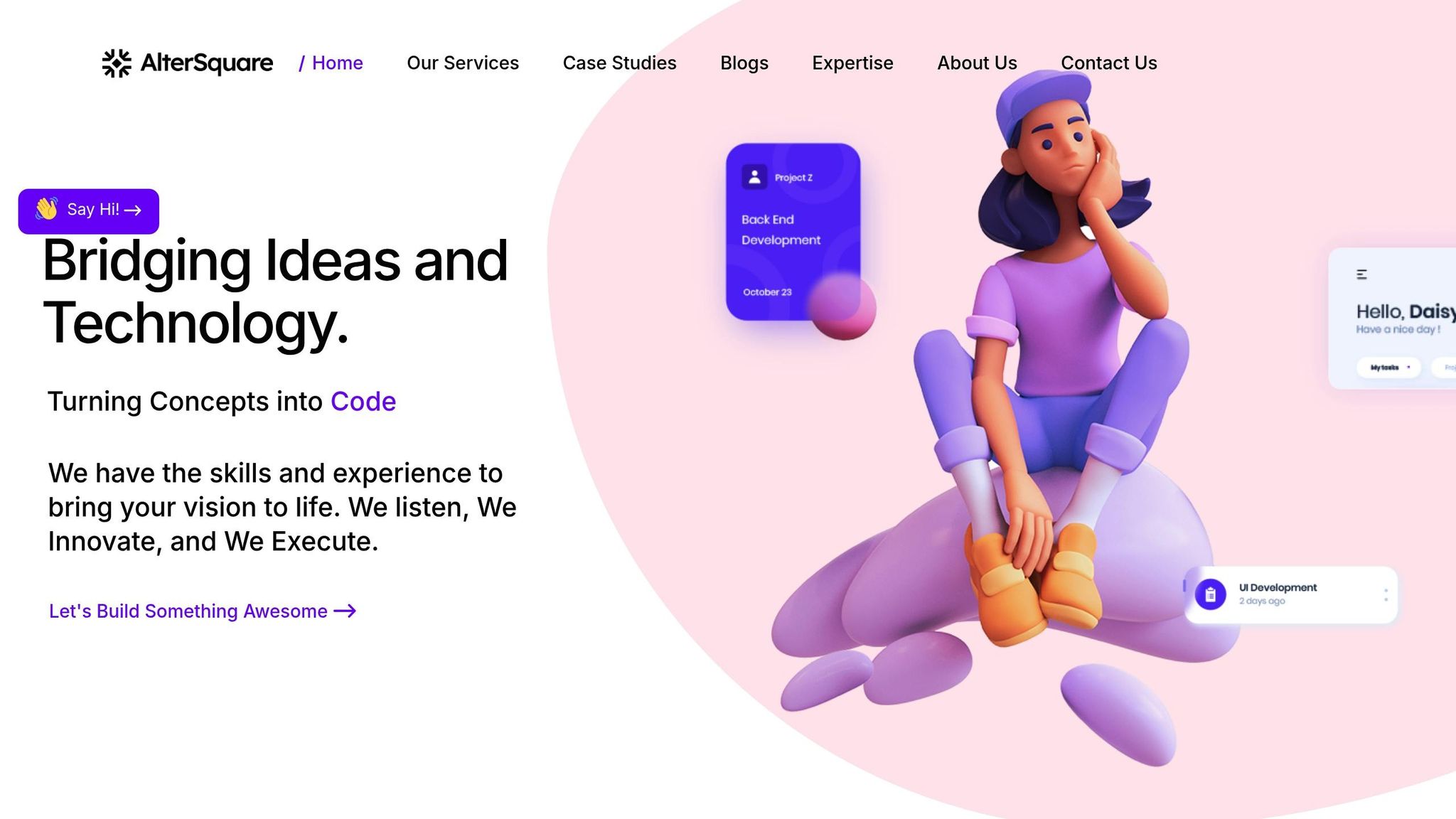Why We Ditched React for Vue: The Developer Happiness Metrics That Shocked Us
Taher Pardawala November 12, 2025
React is powerful, but for our team, it became a source of frustration. Onboarding took too long, decision-making felt overwhelming, and scaling added complexity. Burnout was creeping in. We needed a change.
Vue solved these problems. Its simpler learning curve, clear structure, and built-in tools boosted productivity and morale. Developers got up to speed faster, code reviews became more efficient, and our sprint velocity improved. Vue helped us deliver features quicker and with fewer headaches.
Key takeaways:
- React challenges: Steep learning curve, decision fatigue, and scaling problems.
- Vue benefits: Faster onboarding, easier maintenance, and better team collaboration.
- Results: Happier developers, faster MVP iterations, and improved product quality.
Switching frameworks isn’t just a technical decision – it’s about creating a better experience for your team and delivering better outcomes for your business.
React vs Vue – I Built the Same App in Both Frameworks

React Problems: What Caused Developer Frustration
React exposed several challenges that frustrated developers, particularly in areas like onboarding, decision-making, and scaling. These obstacles often slowed progress and created additional layers of complexity.
Complex Onboarding and Steep Learning Curve
React’s ecosystem made onboarding a daunting task. New team members had to familiarize themselves not just with React, but with a host of accompanying tools like Redux, React Router, Webpack, Babel, and ESLint – each requiring its own configuration. Adding to the challenge was JSX, which blends JavaScript and HTML-like syntax, creating an extra layer of complexity. The shift from traditional class-based programming to React’s composition model also demanded a significant adjustment in thinking, especially for developers accustomed to inheritance-based paradigms.
"One of the primary challenges many developers encounter is understanding the concept of component lifecycle methods and their nuances. Properly handling mounting, updating, and unmounting can be non-trivial, especially when side effects or asynchronous operations are involved." – Ignacio, Senior ReactJS Developer, Ex-The Walt Disney Studios [1]
Too Many Choices and Decision Overload
React’s flexibility, while a strength, often led to decision fatigue. Developers faced endless debates over implementation details – should they use functional or class components? Which state management tool was best? How should styling be approached? These discussions stretched out code reviews and planning sessions, slowing overall progress.
Maintenance and Scaling Difficulties
As the application grew, scaling brought additional headaches. Architectural flaws became more apparent, and state management challenges like prop drilling and tangled logic added to the technical debt.
"State management is another significant hurdle. While React’s built-in state system is excellent for small applications, as an application grows and state requirements become more complex, it can lead to prop drilling and convoluted logic, making global state management solutions like Redux or Context API essential. But with them comes another layer of complexity in learning and properly structuring the application." – Ignacio, Senior ReactJS Developer, Ex-The Walt Disney Studios [1]
Integrating React with older backend systems and third-party libraries wasn’t always seamless either. React’s virtual DOM occasionally clashed with direct DOM manipulations, requiring extra care to avoid rendering issues. On top of that, inconsistent code organization across the team made refactoring harder and increased technical debt. These factors collectively made maintaining and scaling the application a significant challenge.
Why Vue Was the Answer: Key Decision Factors
After grappling with the challenges of React, we knew we needed a framework that could offer a better developer experience without compromising on technical capabilities. Vue quickly emerged as the ideal solution, addressing every major frustration we had encountered.
Easier Learning Curve and Comprehensive Documentation
One of Vue’s standout features is its gentle learning curve. Unlike React, which can feel overwhelming due to its sprawling ecosystem, Vue provides a progressive framework that allows developers to start small and scale up as needed. This meant new team members could begin contributing meaningful code in just hours instead of weeks.
Vue’s single-file components simplify development by combining template, logic, and style in one place. This approach eliminates the need for JSX and makes debugging much more straightforward. Additionally, Vue’s documentation is a game-changer. It’s well-organized, thorough, and packed with practical examples that developers can apply immediately. This clarity and accessibility gave our team the confidence to dive in and start building right away.
Improved Code Maintenance and Clarity
Vue’s opinionated structure brought much-needed consistency to our codebase. It provides clear conventions for organizing code, managing state, and structuring components. This meant any developer could easily understand and contribute to any part of the project without wasting time deciphering patterns.
The framework’s reactive data system simplified state management significantly. For most use cases, Vue’s built-in reactivity was all we needed – no additional libraries like Redux were required. When more advanced state management was necessary, Vuex integrated seamlessly, maintaining the same reactive principles and ensuring a unified experience across the application.
Vue’s structure also promotes a clear separation of concerns. Each component is divided into template, script, and style sections, making it easy to see what the component does, how it works, and how it looks – all at a glance. This organization made code reviews faster and more effective while helping us spot and address issues more easily. It also ensured smooth integration with our existing tools and workflows.
Seamless Integration with Existing Tools
Vue didn’t just improve our development process – it also fit perfectly into our existing ecosystem. Thanks to its incremental adoption model, we were able to introduce Vue gradually, starting with smaller components and scaling up as our team grew more comfortable. This approach avoided the need for a disruptive, full-scale rewrite.
Vue’s tooling ecosystem was another big win. The Vue CLI made project setup quick and straightforward, while Vue DevTools provided an excellent debugging experience compared to what we had with React. The reliable hot module replacement sped up development cycles, allowing us to iterate faster.
Integration with Webpack was smooth and required minimal configuration, unlike the more complex setups we had experienced with React. This simplicity freed up time that we would have otherwise spent troubleshooting tooling issues, allowing us to focus on building features instead.
Finally, Vue’s compatibility with modern JavaScript ensured that our existing code patterns and libraries worked without a hitch. The framework didn’t impose rigid architectural constraints, making the transition painless and reducing risks to our project timeline.
sbb-itb-51b9a02
The Developer Happiness Metrics: Evidence of Improvement
Switching to Vue brought noticeable improvements that could be tracked and measured. By analyzing key development indicators before and after the transition, it became clear that the development process had become more efficient, boosting both team productivity and satisfaction.
Measurable Metrics: Productivity Gains
The data revealed some impressive changes: pull request reviews were completed faster, and features were delivered more quickly. New developers were able to get up to speed faster, thanks to Vue’s straightforward learning curve and well-structured documentation.
Vue’s structured approach and clear conventions also minimized rework during code reviews. On top of that, the built-in debugging and development tools made it easier to identify and fix issues, which streamlined the entire workflow.
Team Feedback: Morale and Collaboration
The productivity gains were matched by a noticeable improvement in team morale. Anonymous surveys showed higher satisfaction levels and less frustration. Many team members highlighted how Vue’s intuitive tools and smoother processes gave them more confidence when working on new features.
The clarity of the codebase also made a big difference. Developers found it easier to collaborate across different parts of the application, and knowledge-sharing within the team became more frequent. These changes didn’t just improve individual satisfaction – they strengthened team cohesion and even contributed to better work-life balance. Together, these shifts paved the way for quicker MVP iterations and a higher-quality product overall.
Business Results: Impact on Product Delivery
Switching frameworks sped up our product delivery and raised the bar on quality.
Faster MVP Iterations and Shorter Time-to-Market
With Vue’s straightforward design, developers could concentrate on creating features without unnecessary complexity. This streamlined approach meant our team could quickly validate ideas and adapt to market feedback. The result? Faster MVP iterations that allowed for rapid testing and timely adjustments.
This newfound efficiency also improved the predictability of sprints and optimized resource allocation. Together, these changes made it easier to meet delivery commitments, earning trust from our stakeholders.
Improved Product Quality and Stakeholder Confidence
The operational benefits didn’t stop at speed; they also translated into better product quality and stronger stakeholder satisfaction.
Vue’s framework supported stable releases while minimizing post-launch issues by catching errors earlier in the process. This led to a noticeable drop in customer support tickets, freeing up resources to focus on developing new features.
Additionally, smoother product demos and enhanced stability boosted stakeholder confidence in our work. The framework’s clear and maintainable codebase made it simpler to apply feedback from user testing, ensuring that change requests were handled efficiently. On top of that, more streamlined quality assurance processes contributed to consistently better outcomes in production.
These results highlight how creating a positive environment for developers not only speeds up development cycles but also ensures more dependable releases.
Conclusion: Lessons for Evaluating Frameworks
Our experience transitioning to Vue highlighted an important truth: the right framework doesn’t just improve code quality – it also boosts team morale. Choosing a framework goes beyond technical specs; it’s about creating an environment where developers thrive.
Key Criteria for Framework Selection
When startups evaluate frameworks, it’s crucial to look beyond just performance stats or popularity rankings. One of the most telling factors we discovered was developer onboarding time. A lengthy onboarding process not only slows feature delivery but also frustrates developers, impacting overall productivity.
Another critical factor is code maintainability. A good framework should allow new developers to understand and modify the codebase within their first week. If it takes extensive documentation or constant guidance from senior team members, scalability becomes an issue.
Don’t underestimate the value of strong documentation and an active community. These resources can dramatically cut down debugging time and directly influence business outcomes, like faster sprint cycles and reduced technical debt.
Balancing Developer Happiness and Technical Efficiency
The best framework isn’t necessarily the one with the most impressive technical specs – it’s the one that strikes a balance between developer productivity and satisfaction. Happy developers are more engaged, write better code, and tend to stay with companies longer, contributing to innovative solutions that drive business growth.
Focusing exclusively on technical efficiency can backfire. While you might gain faster runtime performance, you could lose out on development speed, team morale, and long-term code maintainability. Our shift to Vue demonstrated that prioritizing developer happiness often leads to better business outcomes than chasing pure technical benchmarks.
It’s also essential to consider the total cost of ownership, which includes recruitment, training, and retention. A framework that attracts talented developers and keeps them engaged can significantly reduce hiring expenses and knowledge transfer challenges. For startups, where agility is often more critical than enterprise-level optimization, these human factors play a pivotal role.
How AlterSquare Supports Framework Decisions

At AlterSquare, these lessons shape how we help startups select frameworks. Our Tech Stack Consultation service evaluates frameworks based on business goals, team strengths, and growth plans, ensuring decisions are aligned with long-term objectives.
Through our MVP Development program, we’ve seen how the right framework can accelerate development speed while keeping teams motivated. By incorporating framework evaluation into the discovery phase, we ensure that technical choices support business needs from the start.
For startups dealing with legacy code or rethinking their technical foundations, our Application Modernization services help make framework transitions seamless. We understand that choosing the right framework isn’t just a technical decision – it’s a strategic investment in your team’s future success and productivity.
FAQs
How did Vue’s design and tools enhance team morale and boost productivity?
Vue’s intuitive design and developer-centric tools have significantly boosted team morale and productivity. With features like easy-to-use HTML templates enhanced by directives, Single File Components (SFCs) that combine HTML, CSS, and JavaScript in one place, and its effortless integration into existing projects, the development process became much more streamlined and enjoyable.
These tools helped cut down on unnecessary complexity, eased frustrations, and allowed developers to concentrate on crafting clean, maintainable code. The outcome? A smoother workflow and a clear improvement in team satisfaction.
What impact did switching from React to Vue have on product delivery timelines and overall business outcomes?
The switch from React to Vue brought noticeable benefits to product delivery timelines and overall business performance. Vue’s straightforward design and adaptability allowed the development team to produce cleaner, easier-to-maintain code. This not only cut down on debugging time but also made workflows more efficient. The result? Faster feature releases and more reliable delivery schedules.
On top of that, the change significantly improved developer morale. A more satisfied team translated into higher productivity and better collaboration. With fewer roadblocks and a stronger commitment to delivering top-notch products, the company saw gains in both its financial performance and customer satisfaction.
What should startups evaluate before switching from React to Vue or another framework?
Before making the leap to a new framework, startups need to weigh a few critical factors. First, look at the size and complexity of your project. Some frameworks are better equipped to manage large-scale applications, while others shine with simpler setups.
Next, consider your team’s current expertise. Opting for a framework that matches their skill set can save time on training and help maintain efficiency.
You’ll also want to evaluate how well the framework fits your integration needs with existing tools and systems. Finally, check into the framework’s long-term support and the strength of its community. A strong backing ensures your choice can grow alongside your startup.








Leave a Reply